Buffalo Bill, Rough Riders, and the Manly Image
Brent M. Rogers and Douglas Seefeldt
Wild West Publicity Images of Masculinity
 Promotional poster from the 1898 season. The caption reads, "A squad of Genuine Insurgents, Battle scarred Heroes from the Field of Action." Notice the valiant stance of the Cubans and the pathetic posture of the Spanish troops. Buffalo Bill's Wild West included Cubans in the Congress of Rough Riders in the 1898 season to help draw attention to their plight and to encourage American participation against the Spanish. The Cubans are clearly portrayed as men worth assisting in their fight for Independence. But, it seems that they were not quite capable of finishing the job on their own; they required the assistance of American men.
Promotional poster from the 1898 season. The caption reads, "A squad of Genuine Insurgents, Battle scarred Heroes from the Field of Action." Notice the valiant stance of the Cubans and the pathetic posture of the Spanish troops. Buffalo Bill's Wild West included Cubans in the Congress of Rough Riders in the 1898 season to help draw attention to their plight and to encourage American participation against the Spanish. The Cubans are clearly portrayed as men worth assisting in their fight for Independence. But, it seems that they were not quite capable of finishing the job on their own; they required the assistance of American men.
Cubans. Color lithograph, poster. Image courtesy Library of Congress, American Memory, LC-USZC4-2943.
 Promotional poster from the 1899 season. The caption reads, "The Real Sons of the Soudan, whose brawn and muscle have amazed the world, vividly illustrating their feats of strength, marvelous horsemanship, athletic achievements, gun spinning and pyramid building." Posters featuring Arabs often highlighted their manhood trait of incredible strength, but juxtaposed that with their unrefined and exotic nature. The imagery emphasizes circus-type riding tactics, particularly riding on their heads, and building human pyramids, which called attention to their savage differences. Arabs were depicted as "oriental wonders.
Promotional poster from the 1899 season. The caption reads, "The Real Sons of the Soudan, whose brawn and muscle have amazed the world, vividly illustrating their feats of strength, marvelous horsemanship, athletic achievements, gun spinning and pyramid building." Posters featuring Arabs often highlighted their manhood trait of incredible strength, but juxtaposed that with their unrefined and exotic nature. The imagery emphasizes circus-type riding tactics, particularly riding on their heads, and building human pyramids, which called attention to their savage differences. Arabs were depicted as "oriental wonders.
Arabs. Color lithograph, poster. Image courtesy Library of Congress, American Memory, LC-USZC4-3169.
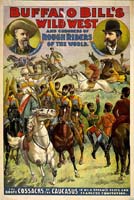 Promotional poster from the 1899 season. The caption reads, "The Brave Cossacks of the Caucasus in wild strange feats and fearless equitation." Despite the Cossacks physical whiteness, the wild and strange tactics to which the poster emphasizes both textually and visually, and which appear strikingly similar to the Arabs, clearly differentiate them from the practical skill and higher manly character associated with other white riders. Notice the prominence of trick riding in the poster, for instance the Cossack riding on his head and the others standing while riding.
Promotional poster from the 1899 season. The caption reads, "The Brave Cossacks of the Caucasus in wild strange feats and fearless equitation." Despite the Cossacks physical whiteness, the wild and strange tactics to which the poster emphasizes both textually and visually, and which appear strikingly similar to the Arabs, clearly differentiate them from the practical skill and higher manly character associated with other white riders. Notice the prominence of trick riding in the poster, for instance the Cossack riding on his head and the others standing while riding.
Cossacks. Color lithograph, poster. Image courtesy Library of Congress, American Memory, LC-USZC4-3170.
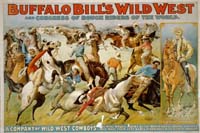 Promotional poster from the 1899 season. The caption reads, "A Company of Wild West Cowboys, the real Rough Riders of the World whose daring exploits have made their very names synonymous with deeds of bravery." The cowboys here display control, efforts to tame bucking broncos, and a practical riding style that made the Western American riders the "real" and best of all. As the Wild West also promoted the cowboy as an intelligent man combined with physical strength and riding skill, one can read in this image the control and practical riding highlighted as associated with intelligence. The American cowboy represented the image of the ideal man.
Promotional poster from the 1899 season. The caption reads, "A Company of Wild West Cowboys, the real Rough Riders of the World whose daring exploits have made their very names synonymous with deeds of bravery." The cowboys here display control, efforts to tame bucking broncos, and a practical riding style that made the Western American riders the "real" and best of all. As the Wild West also promoted the cowboy as an intelligent man combined with physical strength and riding skill, one can read in this image the control and practical riding highlighted as associated with intelligence. The American cowboy represented the image of the ideal man. Cowboys. Color lithograph, poster. Image courtesy Library of Congress, American Memory, LC-USZC4-1479.
 Promotional poster from the 1899 season. The caption reads, "South American Gauchos, the world famous Bolas throwers and all-around Rough Riders of the Pampas." The representation of the Gaucho reads similar to the Cossacks and Arabs, particularly in the difference in dress and the unique skill presented.
Promotional poster from the 1899 season. The caption reads, "South American Gauchos, the world famous Bolas throwers and all-around Rough Riders of the Pampas." The representation of the Gaucho reads similar to the Cossacks and Arabs, particularly in the difference in dress and the unique skill presented. Gauchos. Color lithograph, poster. Image courtesy Library of Congress, American Memory, LC-USZC4-1499.
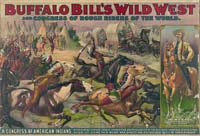 Promotional poster from the 1899 season. The caption reads, "A Congress of American Indians, Representing various tribes, characters and peculiarities of the wily bushy warriors in scenes from actual life giving their weird war dances and picturesque style of horsemanship." In addition to the difference emphasized in the text of this poster, the representation of the Indian congress attacking a white settler train is a clear indication of savagery versus civilization. Native Americans were the antithesis to white American manhood and this attack on the settler's train highlights the era's notion that any savage people represented an attack on white American manhood.
Promotional poster from the 1899 season. The caption reads, "A Congress of American Indians, Representing various tribes, characters and peculiarities of the wily bushy warriors in scenes from actual life giving their weird war dances and picturesque style of horsemanship." In addition to the difference emphasized in the text of this poster, the representation of the Indian congress attacking a white settler train is a clear indication of savagery versus civilization. Native Americans were the antithesis to white American manhood and this attack on the settler's train highlights the era's notion that any savage people represented an attack on white American manhood.
Indians. Color lithograph, poster. Image courtesy Library of Congress, American Memory, LOC LC-DIG-PPMSCA-13514.
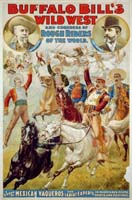 Promotional poster from the 1899 season. The caption reads, "A group of Mexican Vaqueros and lariat experts in marvelous feats, sports and pastimes." The Mexican Vaqueros are depicted in a similar way to the Gauchos, Arabs, and Cossacks and as such represent a type of manhood that did not quite match up with the American cowboy.
Promotional poster from the 1899 season. The caption reads, "A group of Mexican Vaqueros and lariat experts in marvelous feats, sports and pastimes." The Mexican Vaqueros are depicted in a similar way to the Gauchos, Arabs, and Cossacks and as such represent a type of manhood that did not quite match up with the American cowboy.
Vaqueros. Color lithograph, poster. Image courtesy Library of Congress, American Memory, LOC LC-USZC4-1054.
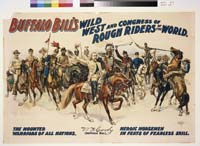
The Congress of Rough Riders of the World specifically highlighted the cowboy, with Cody himself as "finest horseman of them all" as he led and marshaled all of the other free, fearless riders. Cowboys in the show represented virile manhood that helped tame nature and move the outposts of civilization west for women, children, and emasculated civilized men. According to Cody, the American cowboy was all-around ready and able, a splendid horseman, "and in all countries the best and most graceful riders." Notice the dignified looking representation of one of Roosevelt's Rough Riders, far left.
Mounted Warriors. Color lithograph, poster. Image courtesy of the McCracken Library, Buffalo Bill Historical Center.
Each year, Buffalo Bill's Wild West and Congress of Rough Riders of the World publicized the show and its various meanings through widely distributed posters. Millions of people viewed the posters and their imagery each season; such images contributed to the visual idea of manhood. While Show programs, newspaper articles, correspondence, and other text–based materials were important, visual images likewise shaped public perceptions and were perhaps more widely disseminated than text. The image of the Wild West Show drew from a common well of publicly–held perceptions.The posters below comprise a very small sampling of the types of promotional posters used by Buffalo Bill's show concerning Rough Rider groups. Visitors can inspect the visual elements of the posters to develop an understanding of international manhood as comprising the elements of bravery, athleticism, skill, and fearlessness. The posters, in their visual representations and written captions, also highlight differences between the delegates of Rough Riders, particularly in comparison to the American cowboys.
The Congress of Rough Riders introduced two major facets for comparing manhood. First, it emphasized a common masculine character illustrated through fearlessness, athleticism, strength, and equestrian ability. Second, it highlighted manly difference in a hierarchy of men, demonstrating varying degrees of manliness associated in many cases with one's race. all men regardless of race had desirable qualities that rested in the physical: strength, toughness, and athleticism. However, only certain progressive men possessed the balance of the civilized traits of intelligence, gentility, and courteousness. William F. Cody understood this and sought to embody and present the idealization of balanced man in the American rider. These posters, though a small representation, provide visual evidence for Cody's explicit concern about the masculinity and virility of the white American race.
